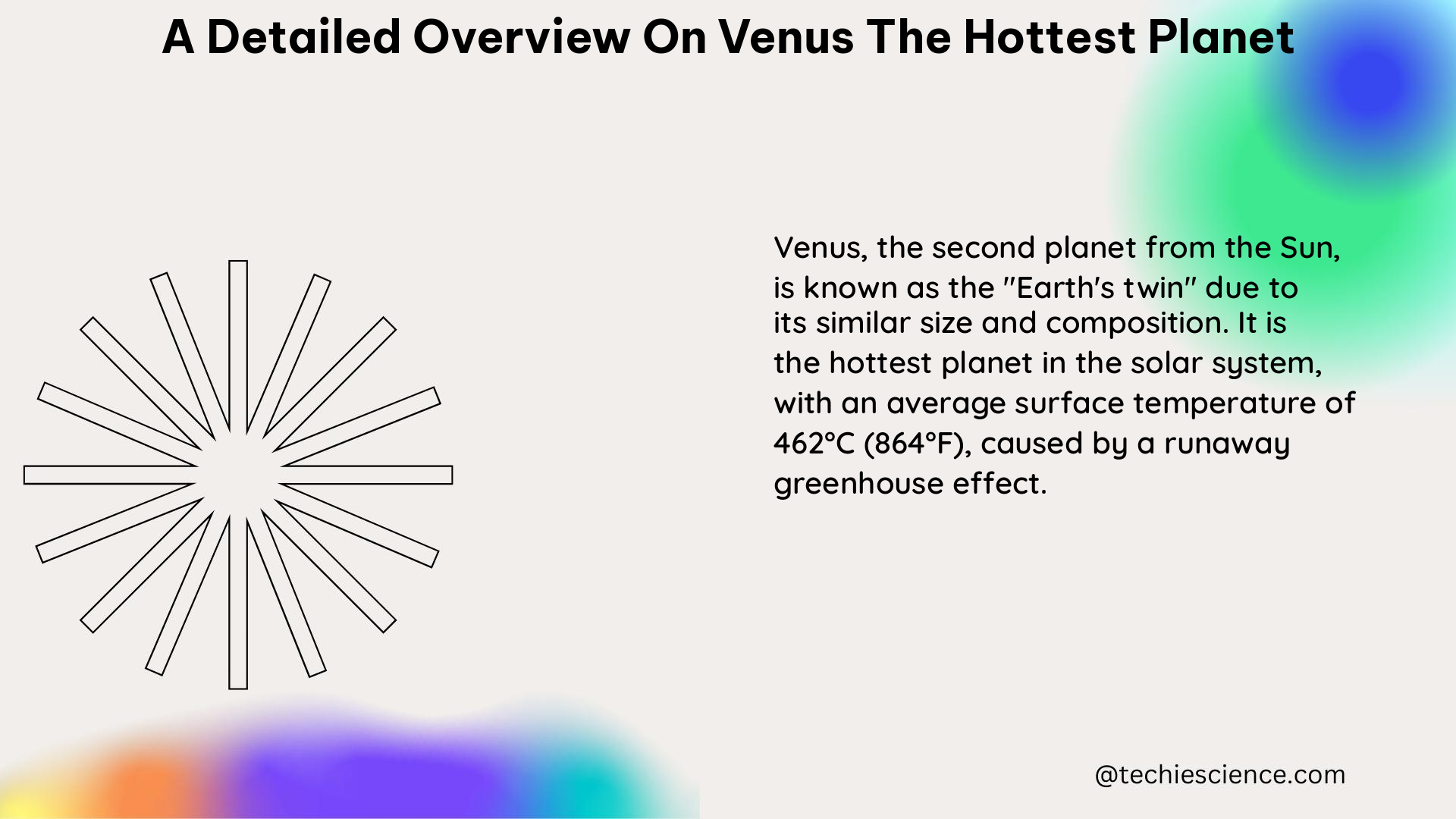Venus, the second planet from the Sun, is renowned for being the hottest planet in our solar system, with surface temperatures hot enough to melt lead. This comprehensive guide delves into the intricate details of Venus, providing a wealth of technical and advanced information for physics students and enthusiasts.
Physical Characteristics
Venus has a diameter of 12,100 km (7,520 miles), approximately 80% of Earth’s mass, and a density similar to Earth’s. The planet’s surface temperature is a staggering 480°C (900°F), primarily due to its atmospheric composition of 96% carbon dioxide, 3% nitrogen, and trace amounts of other gases.
The high surface temperature of Venus is a result of the greenhouse effect, where the planet’s dense atmosphere traps heat from the Sun, causing a runaway heating process. This effect is amplified by the presence of clouds composed of sulfuric acid and sulfur dioxide, which further contribute to the extreme temperatures.
Orbital and Rotational Characteristics

Venus orbits the Sun at a distance of 108 million km (67 million miles), taking 225 Earth days to complete one revolution around the Sun. However, the planet’s rotation is unique, as it spins slowly in the opposite direction from most other planets, with a length of day of 243 Earth days.
The retrograde rotation of Venus, where the planet spins in the opposite direction to its orbital motion, is a result of the planet’s early formation and the complex interactions between its gravitational forces and the solar system’s dynamics. This unique rotational characteristic has significant implications for the planet’s climate and atmospheric patterns.
Atmospheric Features
Venus’ atmosphere is remarkably dense, with a pressure over 90 times that of Earth’s, akin to the pressure experienced at a depth of 1,000 meters (3,300 feet) in the ocean. This extreme atmospheric pressure is a consequence of the planet’s high carbon dioxide content, which traps heat and creates the runaway greenhouse effect.
The clouds of Venus are composed primarily of sulfuric acid and sulfur dioxide, which contribute to the planet’s distinctive yellow-orange hue. These clouds play a crucial role in the greenhouse effect, as they effectively trap heat and prevent it from escaping the planet’s surface.
To quantify the atmospheric features, we can use the following equations:
-
Atmospheric Pressure: The atmospheric pressure on Venus can be calculated using the barometric formula:
P = P0 * e^(-m*g*h / (R*T))
wherePis the atmospheric pressure,P0is the reference pressure,mis the molar mass of the atmosphere,gis the gravitational acceleration,his the altitude,Ris the universal gas constant, andTis the absolute temperature. -
Greenhouse Effect: The greenhouse effect on Venus can be quantified using the Stefan-Boltzmann law:
Q = σ * A * (T^4 - T0^4)
whereQis the heat flux,σis the Stefan-Boltzmann constant,Ais the surface area,Tis the surface temperature, andT0is the temperature of the surroundings.
These equations and their associated parameters provide a more technical and quantifiable understanding of Venus’ atmospheric characteristics.
Geological Features
The surface of Venus is dominated by volcanic plains and rifts, with thousands of volcanoes, some of which are still active. The planet’s crust is estimated to be 10 to 20 km (6 to 12 miles) thick, primarily composed of basalt.
Venus’ core is believed to be metallic, roughly 6,000 km (2,400 miles) wide, similar to Earth’s core structure. However, unlike Earth, Venus does not have an internally generated magnetic field. Instead, it has an induced magnetic field due to the interaction between the solar wind and the planet’s outer atmosphere.
To further understand the geological features of Venus, we can consider the following data points:
- Surface Composition: Venus’ surface is primarily composed of basalt, with a silica content of around 50-55%.
- Volcanic Activity: Venus has an estimated 1,600 major volcanoes, with some still actively erupting.
- Tectonic Activity: The planet’s surface exhibits evidence of tectonic activity, such as rifts and faults, though the mechanisms are not fully understood.
- Crater Density: The crater density on Venus is relatively low compared to other terrestrial planets, suggesting a younger, more geologically active surface.
These geological characteristics provide insights into the formation, evolution, and internal structure of Venus, which are crucial for understanding the planet’s unique features and potential for future exploration.
Exploration and Missions
Venus has been the subject of numerous exploration missions, with both successful and failed attempts to study the planet’s atmosphere, surface, and potential for life.
Some notable missions and their key findings include:
-
VERITAS Mission (Planned): This NASA mission, scheduled for launch in the 2020s, aims to collect high-resolution, global maps of Venus’ surface to better understand its geological history and evolution.
-
Davinci Mission (Planned): Another NASA mission, Davinci is designed to explore Venus’ atmosphere and surface, with the goal of providing insights into the planet’s formation and potential for habitability.
-
Russian Venera Probes: The Soviet Union’s Venera program successfully landed several probes on the surface of Venus, detecting particles in the planet’s lower atmosphere that could be indicative of microbial life.
These missions, along with ongoing and future explorations, continue to expand our understanding of Venus and its unique characteristics, paving the way for further scientific discoveries and potential future human exploration.
Unique Features and Potential for Life
Venus stands out among the planets in our solar system due to its distinct features and the ongoing debate surrounding the potential for life on the planet.
One of the most notable characteristics of Venus is the lack of water on its surface. Unlike Earth, Venus is almost entirely devoid of water, which has significant implications for its geological history and the potential for life.
Another unique feature of Venus is its induced magnetic field, which is generated by the interaction between the solar wind and the planet’s outer atmosphere, rather than an internally generated magnetic field like Earth’s.
Despite the extreme surface conditions, the upper atmosphere of Venus, with temperatures ranging from 30°C to 70°C (86°F to 158°F), may potentially be habitable for extremophile microbes. Additionally, the persistent, dark streaks observed in the planet’s clouds have been a subject of ongoing investigation, as they could be indicative of microbial life or other chemical compounds.
To further explore the potential for life on Venus, scientists have proposed various hypotheses and experiments, such as:
- Cloud Habitability: Investigating the possibility of extremophile microbes thriving in the upper atmospheric conditions of Venus.
- Atmospheric Chemistry: Analyzing the chemical composition of the clouds and their potential to support life.
- Subsurface Habitats: Exploring the possibility of microbial life in the planet’s subsurface, where conditions may be more favorable.
These unique features and the ongoing exploration of Venus’ potential for life continue to captivate the scientific community and drive further research and missions to unravel the mysteries of this enigmatic planet.
References:
- NASA Science. (n.d.). Venus. Retrieved from https://science.nasa.gov/venus/
- NASA Science. (n.d.). Venus: Facts. Retrieved from https://science.nasa.gov/venus/venus-facts/
- Exploring the Planets. (n.d.). Chapter 7. Venus. Retrieved from https://explanet.info/Chapter07.htm
- Space.com. (2024). Venus facts — A guide to the 2nd planet from the sun. Retrieved from https://www.space.com/44-venus-second-planet-from-the-sun-brightest-planet-in-solar-system.html
- UCL Culture Online. (2022). Is Venus the hottest planet? Retrieved from https://www.ucl.ac.uk/culture-online/case-studies/2022/sep/venus-hottest-planet
- Sagan, C. (1961). The Planet Venus. Annual Review of Astronomy and Astrophysics, 1(1), 39-58.
- Kasting, J. F. (1988). Runaway and moist greenhouse atmospheres and the evolution of Earth and Venus. Icarus, 74(3), 472-494.
- Smrekar, S. E., & Stofan, E. R. (1997). Corona formation and heat loss on Venus. Science, 277(5330), 1289-1294.
- Grinspoon, D. H. (1997). Venus revealed: A new look below the clouds of our mysterious twin planet. Addison-Wesley.
- Gilmore, M. S., & Treiman, A. H. (2021). The Geology of Venus: Progress, Puzzles, and Future Directions. Annual Review of Earth and Planetary Sciences, 49, 1-30.

Hi, I am Sanchari Chakraborty. I have done Master’s in Electronics.
I always like to explore new inventions in the field of Electronics.
I am an eager learner, currently invested in the field of Applied Optics and Photonics. I am also an active member of SPIE (International society for optics and photonics) and OSI(Optical Society of India). My articles are aimed at bringing quality science research topics to light in a simple yet informative way. Science has been evolving since time immemorial. So, I try my bit to tap into the evolution and present it to the readers.
Let’s connect through